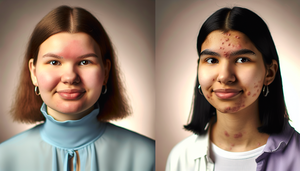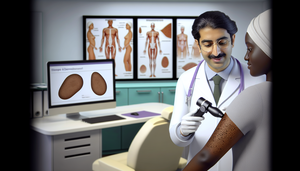
Hyponatremia and SIADH: Understanding Sodium Alteration Mechanisms in Electrolyte Disorders
Explore the mechanisms behind hyponatremia and SIADH for effective diagnosis and treatment.
Read more
Lymphoma vs. Tuberculosis: Identifying the Cause of Persistent Swollen Lymph Nodes and the Role of Biopsy in Diagnosing Acid-Fast Bacilli
Accurate differentiation between lymphoma and lymph node tuberculosis is crucial for appropriate patient management.
Read more
Acute Kidney Injury vs. Chronic Kidney Disease: Distinguishing Through Laboratory Tests and Creatinine Levels
Discover how laboratory tests and renal ultrasonography differentiate between acute kidney injury and chronic kidney disease.
Read more
Chronic Fatigue Syndrome vs. Depression: A Multidisciplinary Approach to Persistent Fatigue and Sleep Disturbances
Discover how to differentiate between chronic fatigue syndrome and depression for effective treatment.
Read more
Septic Arthritis vs. Gout: Differential Diagnosis of Acute Joint Pain and the Role of Joint Aspiration and Gram Stain
Discover how to differentiate between septic arthritis and gout in cases of acute monoarthritis.
Read more
Iron Deficiency Anemia vs. Anemia of Chronic Disease: Interpreting Ferritin and Serum Iron Levels in Low MCV Cases
Discover how to differentiate between iron deficiency anemia and anemia of chronic disease by interpreting iron values.
Read more
Substance-Induced Psychosis vs. Schizophrenia: Diagnostic Criteria in Drug Use Contexts and Temporal Evolution
Differentiating between substance-induced psychosis and schizophrenia is crucial for effective treatment.
Read more
Borderline Personality Disorder vs. Bipolar Disorder: Effective Pharmacological Management of Mood Swings and Emotional Instability
Explore the key differences between BPD and bipolar disorder for effective and personalized treatment.
Read more
Somatic Symptom Disorder vs. Fibromyalgia: A Comprehensive Psychosomatic Evaluation of Chronic Pain and Comorbidities
Explore the key differences between somatic symptom disorder and fibromyalgia to enhance clinical management.
Read more
ADHD and Anxiety: Understanding Concentration Difficulties and Hyperactivity in Adult Patients
Explore how ADHD and anxiety interact in adults, complicating diagnosis and treatment.
Read more
Panic Disorder vs. Cardiac Arrhythmia: Exploring the Etiology of Palpitations and Panic Attacks through ECG Analysis
Differentiating between panic disorder and cardiac arrhythmia is crucial for appropriate treatment.
Read more
Obsessive-Compulsive Disorder vs. Generalized Anxiety: Differentiating Symptoms of Compulsions and Excessive Worry
Discover how to differentiate OCD from generalized anxiety for more effective treatment.
Read more
Schizophrenia vs. Schizoaffective Disorder: Defining the Diagnostic Line for Hallucinations and Affective Symptoms
Explore the key differences between schizophrenia and schizoaffective disorder for accurate diagnosis.
Read more
Major Depression vs. Bipolar Disorder: The Importance of History and Psychiatric Evaluation in Managing Mood Stabilizers
The precise distinction between major depression and bipolar disorder is essential for effective treatment.
Read more
Erythema Multiforme vs. Stevens-Johnson Syndrome: Recognizing Clinical Severity and Target Lesions in Mucous Membranes
Discover how to differentiate and properly manage erythema multiforme and Stevens-Johnson syndrome.
Read more
Shingles vs. Contact Dermatitis: A Guide to Vesicular Lesions and Neuropathic Pain Management
Discover how to differentiate between shingles and contact dermatitis for effective treatment.
Read more
Scabies vs. Eczema: Key Factors for Diagnosing Nocturnal Pruritus and Linear Lesions
Discover how to differentiate between scabies and eczema through nocturnal pruritus and characteristic lesions.
Read more
Rosacea vs. Acne: Differential Diagnosis and Topical Treatment for Facial Erythema and Papules
Discover how to effectively differentiate and treat rosacea and acne to enhance your patients' quality of life.
Read more
Urticaria and Drug Allergy: How to Identify the Underlying Etiology with Provocation Tests and Antihistamines
Discover how to differentiate between urticaria and drug allergy for effective treatment.
Read more
Melanoma vs. Seborrheic Keratosis: Key Insights for Early Diagnosis of Skin Cancer and Malignant Signs in Pigmented Lesions
Discover how dermatoscopy and new technologies enhance the differential diagnosis between melanoma and seborrheic keratosis.
Read more